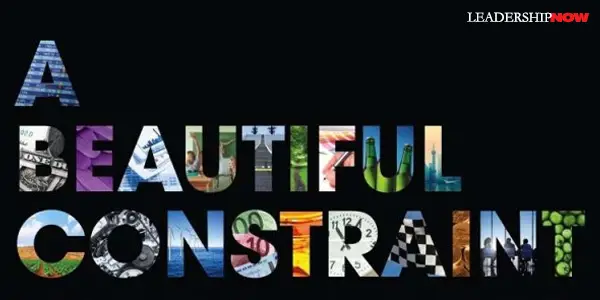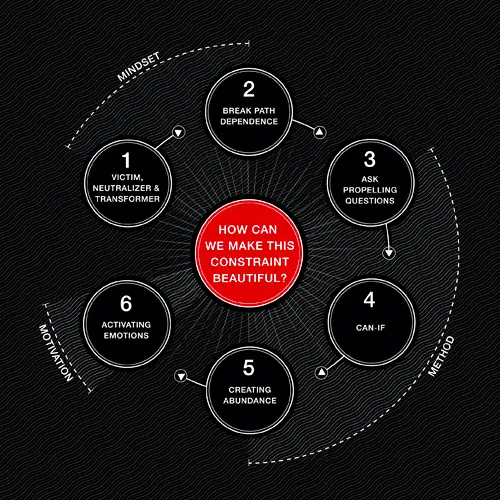 |
 |
01.22.15

A Beautiful Constraint
TYPICALLY we look at a constraint as a negative. A problem to be solved. But what if a constraint was the gift that opened up previously unimagined possibilities? What if a constraint was the gift that took you to the next level? Authors Adam Morgan and Mark Barden remind us in A Beautiful Constraint that Google’s home page is as simple as it is because that was the limit of Larry Page’s coding ability at the time. The overall-wearing hero Mario is as colorful as he is because of the challenges of eight-bit technology. And which of us would be using Twitter at all today if it had a limit of 14,000 characters rather than 140? We are all faced with the challenge of growing within the constraints of time, resources, method and /or people. Sometimes constraints are imposed on us and sometimes we benefit by placing constraints on ourselves. “We are living in an era of extraordinary people rewriting our sense of what is possible. They make an unarguable case that a constraint should be regarded as a stimulus for positive change—we can choose to use it as an impetus to explore something new and arrive at a breakthrough. Not in spite of the constraint, but because of it.” Organizations of all types—business, churches and schools—and people from all walks of life would benefit from understanding how to reframe a constraint into a better way of doing something. We begin the process by creating the right mindset. We need to increase our ambition relative to the constraint not to scale back our ambition to satisfy the constraint. That’s victim mentality. And that’s usually where we begin. Better yet, we can try to find a way to neutralize the constraint so we can deliver on our ambition. But the authors have created a path for us to become transformers—to find a way to use a constraint as an opportunity, possibly even increasing our ambition along the way.  Often transformers will impose constraints upon themselves to force themselves to unearth different, possibly transformative strategies and solutions. This helps to reduce path dependence or the assumptions and ways of thinking about solutions that define “the way we do things around here.” “Today’s path is really yesterday’s path.” We must examine all of the ingrained habits that may stand in the way of our being able to see and realize the possibilities in a constraint. To bind our bold ambition to a significant constraint we have to ask a propelling question. The kind of “what if…?” question that forces us to think and behave in a better way. “If we don’t ask propelling questions of ourselves, someone is going to ask them of us, and by that time we will be behind the curve.” To answer a propelling question we need to answer not with a “we can’t because” statement but with a “we can if” statement. It focuses the nature of the conversation on how something could be possible and not on whether it would be possible. Then we get resourceful. What stops us from being more resourceful is the way we think about resources. We tend to think of the resources available to us as the ones within our immediate control. But there are all kinds of resources outside of our immediate control. One method is to create shared agendas. “We, who might appear to have little, need to help them see that we have what they want.” There are organizations that routinely embrace constraints to make themselves better. The beautiful constraint process cannot be managed, it must be led. “When making constraints beautiful, motivation is method. Breakthrough happens when a propelling question meets strong emotions. Without activating the right emotions, it will be too easy to regress to the victim mindset.” The authors note that “if we are heading into a more constrained future, then how we manage those constraints will determine how we progress.” As a leader, steering your organization towards constraints sooner rather than later, is an important source of competitive advantage. Raising the level of ambition alongside a constraint encourages growth and learning—both individually and organizationally—because it causes us to reexamine our current paths, assumptions, and ways of thinking. A Beautiful Constraint is a outstanding book with inspiring examples that will spark your imagination to create your own beautiful constraint. It should be standard issue to every student as the thinking described here will serve them well in life. What constraint will you go and make beautiful? 
Posted by Michael McKinney at 10:02 PM
|
BUILD YOUR KNOWLEDGE
 

How to Do Your Start-Up Right STRAIGHT TALK FOR START-UPS 
Grow Your Leadership Skills NEW AND UPCOMING LEADERSHIP BOOKS 
Leadership Minute BITE-SIZE CONCEPTS YOU CAN CHEW ON 
Classic Leadership Books BOOKS TO READ BEFORE YOU LEAD |